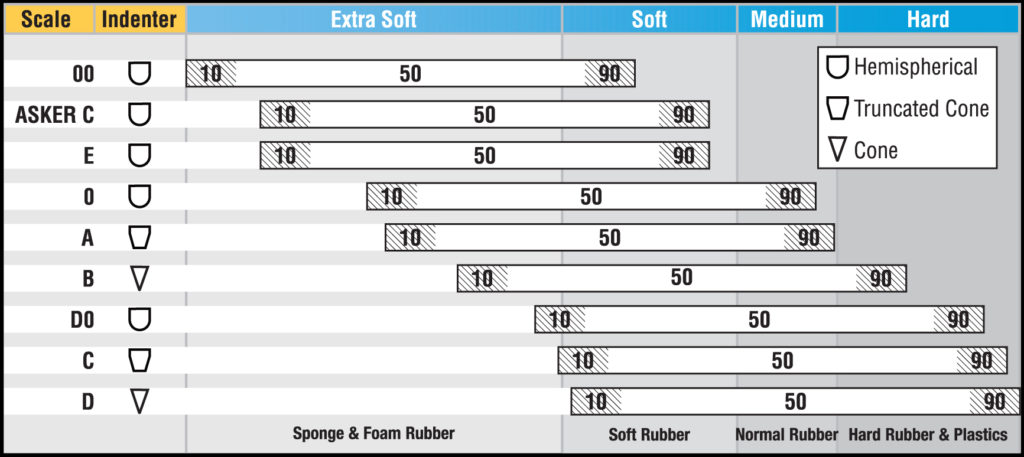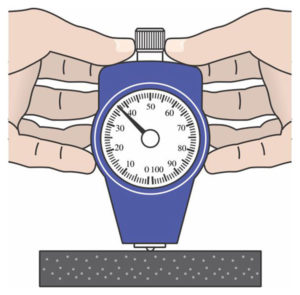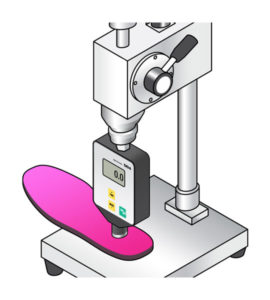IMADA, Inc. is dedicated to providing accurate measuring devices for quality assurance and production control needs. Some of the many high-quality instruments we supply are analog and digital durometers. Durometers are important to the manufacturing sector in measuring the hardness characteristic of certain materials.
What it is
But what are durometer scale readings, exactly, and what are they used for?
The term “durometer” is also used to indicate the rating of the material on a hardness scale. The higher the number on the durometer scale, the harder (indentation hardness), the material is, or the greater resistance it has. For example, inline skate wheels are sold and categorized using their material hardness durometer rating. Like 60 durometer skate wheels. These ratings are determined by an instrument known as a durometer.
In this article, we’ll discuss specific types of durometer and hardness readings for rubber and plastics. By measuring the resistance to indentation of polymers, elastomers, and rubbers, manufacturers are able to comply with industry standards for certain products.
Durometers come in both mechanical (analog) and digital and have different indenter types: cone, truncated cone, hemispherical and flat, and different indenter push forces.
Hardness can be read on either an analog spring scale or digital depending on your application and requirements.
Why Measure Durometer Hardness?
Manufacturers require consistency in their products and accuracy in their quality control instruments that conduct hardness tests. Some examples of products that durometers are used to test during manufacturing are skate wheels, shoe inserts, hard hats, and car tires. These items all require consistent hardness of the material to be able to fulfill their intended purposes.
Consistency in hardness measurement for the range of materials such as hard rubbers, extremely soft rubbers, mold rubber, and sponge require different scales to measure the range of hardness.
The Nitty Gritty
How to Measure Hardness
Durometers for rubber and plastics, commonly measure using “Shore scales” and are named for the man who developed the method of measurement and first instrument. Durometers come in a variety of hardness scales based on the material being measured. The scales are achieved using different combinations of indenter shape and force applied depending on the hardness of the material being measured. Industry standards dictate the geometry and design of different indenters. For example, ASTM D2240 A, also known as Shore A, uses a truncated cone and ASTM D2240 D uses a cone indenter. Another commonly used scale is Asker C, which is used for softer materials such as a running shoe sole and uses a hemispherical indenter. These different scales each have their application. See below for an example of a rubber/plastic hardness chart.

Rubber hardness testing methods differ depending on the durometer scale being used, but samples being tested must share certain characteristics. Samples should be at least 6 mm (1/4 inch) thick and flat. Thin samples of rubber or plastic should be stacked together.
The most basic test for measuring the hardness of a material is using an analog handheld durometer. Pressure should be applied gradually to the rubber using the durometer. It is important to apply pressure evenly and without shock load to the indenter. Shock load is a sudden and drastic increase in load, so maintaining consistent pressure is key.
To establish a baseline of average hardness measurements, multiple test points are used. Test points should be separated by at least 6 mm (1/4 inch), and at least 12 mm (1/2 inch) from the edge of the sample.
As the durometer is pressed against the sample, the material resistance force and indenter spring load balance. The depth of the indenter is measured, which provides a measure of the material’s hardness. Values are based upon a 100 point scale. However, as time elapses the peak indicator will “creep” back so that a reading taken a few seconds after the indenter makes contact with the sample will be less than the peak reading. Imada durometers offer a peak indicator as an option to more closely monitor the difference between peak and “creep”.
Different Durometers
There are different types of durometer hardness testers to suit your application. At IMADA, Inc., we carry handheld durometers, constant load stands, and auto-loading durometers with pneumatic and mechanical features that eliminate speed and load variables. Each type of our durometers testers is available in different durometer scales, including Shore A, Shore D, Shore E, Asker C which measure the range from hard to soft.
Handheld Durometers

Handheld analog durometers are typically the best value due to their relatively simple design. This basic test requires applying constant pressure by hand. They measure common Shore and Asker scales, which include the range of material from sponge and soft rubber to hard rubber and hard plastic.
Constant Load Stands
Mounting the durometer to a constant load stand eliminates speed and force variables when testing by hand and ensures the most consistent results. A standard weight applies even pressure to the material that increases repeatability. Pneumatic speed control eliminates another hand testing variable and flexible couplings allow the presser foot to make complete contact with angled surfaces. These stands can use any of the durometer scales except type F.
Auto-Loading Durometers
Hardness testing can be automated using an auto-loading durometer. Auto loading durometers are motorized stands that apply constant speed and force to the sample material and automatically return to the start position at the press of a button. A flexible coupling, may also be used to enable the presser foot of the durometer to make perfect contact on angled surfaces. They are available in Shore A, D, or Asker C hardness scales.
Calibration and Maintenance of Equipment
Ensuring your equipment remains accurate and in proper operation, accessories can be used to test equipment regularly. For example, reference specimens with known rubber material hardness can be utilized to quickly verify equipment’s accuracy and functionality. Height gauges can also be used to ensure the durometer is working correctly by checking the height of the indenter point. These work for Shore A, Shore D, and Asker C durometers.
If your durometer is measuring incorrectly, IMADA, Inc. offers calibration and repair services to provide a calibration certificate traceable to NIST or ISO 17025 if required . Normally, within two days of receiving your unit, we provide an analysis of the problem with a repair quote and within two days of your approval, we will repair and ship the unit back to you. Expedited service is also available.
Summary
Hopefully, this answered some questions on what are durometer scales and the different types of durometer testers. Durometers measure the hardness of most rubber materials and plastics for anything between your running shoe sole, a car tire, sponges, etc. Measuring the rubber hardness of car tires is important. Too soft and your vehicle gets difficult to steer, and too hard you begin to lose grip on the road.
Choosing the right durometer for your application depends on the material being tested. Material hardness is important for every industry and accurate equipment is key.



